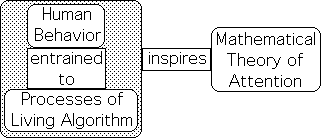Synopsis: This page provides a brief introduction to my Theory of Attention. The theory includes the following propositions: Attention employs a single algorithm to impart dynamic Meaning to data streams. The Living Algorithm (LA) is the name we have given to this computational tool that transforms Raw Data into useful Information. The LA generates a probabilistic mathematical system that we call Data Stream Dynamics (DSD). DSD is the mathematical foundation of our Theory of Attention. Just as both tides and living systems align with the gravitational rhythms of the Sun and Moon, Attention consistently aligns with the mathematical rhythms of DSD.
The relationship between mathematics and human behavior fascinates me. Why? I firmly believe that understanding the mathematical processes that guide our actions could enable us to make better choices in order to better fulfill our potentials. My interests inspired a lifetime of research that ultimately resulted in the development of a mathematical theory regarding the Rhythms of Attention.

The Theory of Attention contains the following rules:
1) Attention has a limited duration – a Pulse.
2) After completing a Pulse, Attention requires a shift in focus to have another Pulse.
3) Attention is attracted to acceleration.
4) Sustained Attention Experiences (SAEs) are the primary source of Human pleasure.
5) Negative SAEs prevent humans from having a Positive SAE.
6) Most, if not all, Negative SAEs are based in a sense of Self.
What inspired this theory? I noticed many examples of patterns of correspondence1 between experimentally-verified evidence regarding living systems and the mathematics of a single algorithm, deemed the Living Algorithm2. More specifically, it seems that many different types of human behavior associated with attention tend to become entrained to the Living Algorithm's mathematical processes3. Further significant biological processes also associated with attention seem to have evolved to take advantage of these same processes4.

To make sense of the math/data connection, I entertained the notion that the Human Attention Network might employ the Living Algorithm to digest data. There were at least 4 reasons that this was a plausible assumption: 1) The LA reveals the ongoing rates of change, i.e. derivatives, of any data stream, the informational food of living systems. 2) The computations are simple and the memory requirements are minimal. 3) Data stream derivatives could easily act as ongoing predictive descriptors that would certainly facilitate survival. 4) These same measures could be employed to filter out random data streams in order to focus on meaningful data streams.

These possibilities combined with an abundance of empirical evidence led me to eventually make these 2 startling assumptions: 1) The Human Attention Network employs the Living Algorithm as a mathematical interface with environmental information5.

2) There is a synergistic relationship between Attention and the processes of the Living Algorithm that seems to shape many significant features of human behavior.

On the broadest level, the Attention/Math synergy seems to play a huge part in the ubiquitous pulse-like nature of human behavior. This pulse-like behavior permeates our existence – for instance our daily wake/sleep cycle and our attention span. In turn, our attention span determines the length of lectures, concerts, sporting events, and even conversations. Further, our pulse-like behavior tends to follow, i.e. entrain to, certain patterns that are reflected in the mathematical processes of the Living Algorithm. The most significant of these are: 1) the limited attention span, 2) the negative impact of interruptions, and 3) the necessity of down time to refresh attention.

Many of these common human phenomena remain scientific mysteries. For instance, scientists continued to be mystified by the necessity of sleep, the disproportionate impact of interruptions, and our limited attention span.
When applied to itself, the Living Algorithm generates a mathematical system deemed Data Stream Dynamics (DSD).

Data Stream Dynamics has many obvious parallels with traditional material dynamics in that they share a similar architecture of constructs6. Just as scientists employ traditional dynamics to explain material behavior, DSD provides significant explanatory power regarding living behavior, especially the rhythms of human attention.

The primary purpose of this website is to provide a justification for our Theory of Attention. There are many types of articles. One set provides the reasoning behind our audacious claims. Another group examines the evidence for our theory. A third type explores the mathematical foundation along with the implications. Return to the Article List for links and descriptions of the current group of articles.
Enjoy!
Footnotes
1 Glossary items are highlighted in green italics. The glossary frequently has a brief description of the item followed by a link to a more comprehensive article (highlighted in underlined, blue italics).
2 For a summary of the special features of the Living Algorithm, check out Mathematics of the Moment.
3 Following are but a few of the scientifically accepted phenomena that seem to be entrained to the LA's mathematical processes: the necessity of sleep, the harm of sleep deprivation, the disproportionate impact of interruptions on a productive session, and our limited attention span epitomized by the 10-minute rule. Further, the scientific community continues to be mystified as to the reasons behind these behavioral phenomena.
4 Posner's Attention Model and Dement's 'Opponent' Process Model of Sleep are both well-established biological processes that are universally accepted by the scientific community. Both of these biological networks seem to have evolved to take advantage of the Living Algorithm's mathematical processes.
5 Check out Attention’s Mathematical Tool for some reasons why the Living Algorithm is uniquely suited to provide the mathematical interface between human attention and sensory information. The article also summarizes the inherent limitations of traditional mathematical methods.
6 Data Stream Dynamics is an entire Notebook that is devoted to both developing the mathematics behind the dynamics of data streams and establishing the parallels with the traditional dynamics of matter.